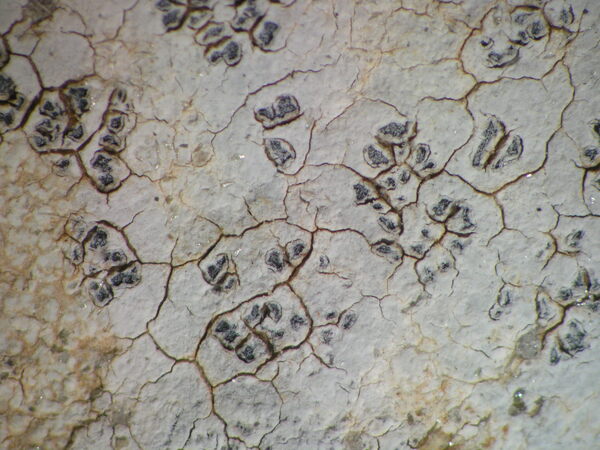Aspicilia subfarinosa (J. Steiner) Senkard. & Sohrabi
Mycotaxon, 115: 101, 2011. Basionym: Lecanora subfarinosa J. Steiner - Ann. naturhist. Mus. Wien, 34: 38, 1921.
Synonyms: Aspicilia farinosa var. subopegraphoides (Werner) S.Y. Kondr.; Aspicilia substerilis Sipman
Distribution: N - Frl (Sipman 2007). C - Sar (Sipman 2007).
Description: Thallus crustose, episubstratic, 0.1-0.15 mm thick, continuous to finely rimose (especially around the apothecia), chalky-white with a farinose surface, forming large patches to over 5 cm wide, without a dark prothallus. Cortex paraplectenchymatous, of submoniliform, perpendicularly arranged hyphae (but structure poorly visible, the cortex being fully filled by coarse crystals), sometimes overlain by an epinecral layer; medulla white to rarely ochraceous in lower parts, filled by 5-10 μm wide crystals, I-. Apothecia lecanorine-aspicilioid, immersed in the thallus and separated by a fissure, 0.2-0.8(-1) mm across, rounded to elongate, often confluent, with a grey-white-pruinose, concave disc, and a thin, white, often poorly visible thalline margin. Epithecium brown to green, N+ emerald green; hymenium colourless, 100-150 μm high, I+ persistently pale blue or partly turning yellow; paraphyses branched, submoniliform and 2.5-4 μm thick in lower part, the uppermost cells 4-5 μm wide; hypothecium colourless, without a basal algal layer. Asci (2-)4-spored, subclavate, the thin outer coat K/I+ blue, the wall and apical dome K/I-. Ascospores 1-celled, hyaline, broadly ellipsoid, 20-37 x 16-35 μm, often absent or poorly developed. Pycnidia immersed, pyriform, with a black, punctiform ostiole and a colourless wall. Conidia thread-like, straight, 6-18 x 0.6-1 μm. Photobiont chlorococcoid. Spot tests: cortex and medulla K-, C-, KC-, P-. Chemistry: without lichen substances. Note: a Mediterranean-Turanian species growing on calcareous rocks in exposed situations, perhaps more widespread in Italy below the subalpine belt. Superficially similar to Lobothallia controversa, this species differs in having only 4 spores per ascus, and belongs to Circinaria. According to Roux & coll. (2020), however, the species is almost indistinguishable from xerophilous forms of Circinaria calcarea, which differ only in DNA.
Growth form: Crustose
Substrata: rocks
Photobiont: green algae other than Trentepohlia
Reproductive strategy: mainly sexual
Commonnes-rarity: (info)
Alpine belt: absent
Subalpine belt: absent
Oromediterranean belt: absent
Montane belt: very rare
Submediterranean belt: very rare
Padanian area: absent
Humid submediterranean belt: very rare
Humid mediterranean belt: extremely rare
Dry mediterranean belt: absent

Predictive model
Growth form: Crustose
Substrata: rocks
Photobiont: green algae other than Trentepohlia
Reproductive strategy: mainly sexual
Commonnes-rarity: (info)
Alpine belt: absent
Subalpine belt: absent
Oromediterranean belt: absent
Montane belt: very rare
Submediterranean belt: very rare
Padanian area: absent
Humid submediterranean belt: very rare
Humid mediterranean belt: extremely rare
Dry mediterranean belt: absent

Predictive model
 Index Fungorum
Index Fungorum
 GBIF
GBIF


